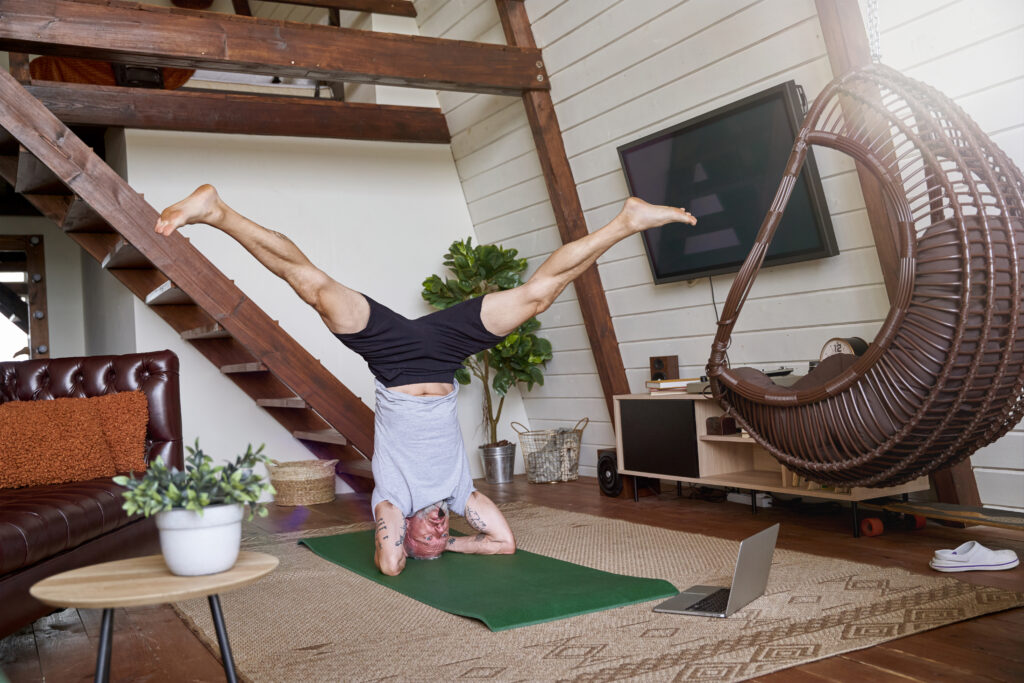Gymnastics is a sport that combines strength, flexibility, balance, and coordination. While many people associate gymnastics with training in a gym or specialized facility, the truth is you can effectively practice many gymnastics exercises at home. Whether you’re a beginner wanting to learn the basics or an experienced gymnast looking to maintain your skills, gymnastics exercises at home provide a convenient and effective way to improve your fitness and body control.
In this article, we will explore the best gymnastics exercises at home that you can perform with little to no equipment, how to do them safely, and the benefits of incorporating gymnastics into your home workout routine.
Why Practice Gymnastics Exercises at Home?
Gymnastics exercises at home are ideal for several reasons:
- Accessibility: You don’t need a gym membership or specialized equipment.
- Flexibility: Train anytime that fits your schedule.
- Cost-effective: No expensive equipment or classes needed.
- Full-body workout: Gymnastics moves engage multiple muscle groups for a balanced fitness routine.
- Improved body awareness: These exercises enhance coordination and control.
Whether space is limited or you want to avoid crowded gyms, gymnastics exercises at home make it easy to stay active and fit.
Essential Gymnastics Exercises at Home
You can build a strong foundation by focusing on these key gymnastics exercises at home that target strength, flexibility, and balance.
1. Handstands
Handstands are one of the most iconic gymnastics moves and excellent for developing upper body and core strength. To practice handstands at home, start by kicking up into a handstand against a wall for support. Focus on keeping your body straight and tight from head to toes.
Tips:
- Warm up your wrists and shoulders first.
- Practice holding for 10–30 seconds and gradually increase time.
- If wall handstands are too challenging, begin with donkey kicks.
2. Bridges
Bridges are fantastic for spinal flexibility and strengthening your back, shoulders, and glutes. To do a bridge at home, lie on your back with your knees bent, feet flat on the floor, and hands beside your ears. Push through your hands and feet to lift your hips and chest off the ground, forming an arch.
Tips:
- Hold the position for 10–20 seconds.
- Keep your feet and hands firmly planted.
- Perform 3 sets to improve back flexibility.
3. Planks
Planks are a simple yet powerful exercise to build core stability—a crucial element in all gymnastics movements. You can do forearm or straight-arm planks at home without any equipment.
Tips:
- Maintain a straight line from head to heels.
- Engage your abdominal muscles throughout.
- Hold for 30 seconds to 1 minute and repeat 3 times.
4. Cartwheels
Cartwheels improve agility, balance, and coordination. They are a fun gymnastics exercise you can practice indoors or outdoors. To perform a cartwheel at home, start in a lunge position, place your hands on the ground, and kick your legs over your body, landing on the opposite foot.
Tips:
- Use a soft surface to avoid injury.
- Break down the move into parts to practice hand placement and leg kicking.
- Practice slowly, increasing speed as you gain confidence.
5. Leg Raises
Leg raises target your lower abdominal muscles and hip flexors, enhancing your ability to lift your legs in various gymnastics skills. Lie flat on your back and slowly raise your legs without bending the knees, then lower them back down.
Tips:
- Avoid arching your lower back.
- Perform 3 sets of 10–15 repetitions.
- Engage your core throughout.
Stretching and Warm-Up
Before starting gymnastics exercises at home, warming up is vital to prevent injuries. Spend 5–10 minutes doing light cardio (jumping jacks, jogging in place) and dynamic stretches (arm circles, leg swings). After your workout, stretch to improve flexibility and help muscles recover.
Safety Tips for Gymnastics Exercises at Home
- Always practice on a soft surface such as a yoga mat, carpet, or grass.
- Listen to your body; don’t push beyond your limits to avoid injury.
- Focus on form and control over speed.
- Use walls or furniture for support when learning new moves like handstands or cartwheels.
- If possible, have a spotter when attempting more advanced exercises.
Benefits of Regular Gymnastics Exercises at Home
Incorporating gymnastics exercises at home into your routine offers numerous benefits:
- Improved muscle strength: Build upper body, core, and leg strength.
- Enhanced flexibility: Stretching and movements increase joint mobility.
- Better balance and coordination: Key to mastering gymnastics and useful in everyday life.
- Increased body awareness: Learn to control and move your body with precision.
- Convenience: Train anywhere without the need for expensive equipment or gym access.
Creating Your Home Gymnastics Routine
Start by dedicating 20–30 minutes, 3 to 4 times a week, focusing on a mix of strength exercises, flexibility training, and skill practice. For example:
- Warm-up (5 minutes)
- Handstand practice (5 minutes)
- Planks and leg raises (10 minutes)
- Cartwheels or bridges (10 minutes)
- Cool down and stretching (5 minutes)
Adjust the routine based on your fitness level and progress.
Gymnastics exercises at home are a fantastic way to develop a strong, flexible, and balanced body while enjoying the convenience of training in your own space. With consistent practice and focus on proper technique, you’ll see your skills improve and your overall fitness level rise.
Start your gymnastics journey today by incorporating these exercises into your home workout routine!

